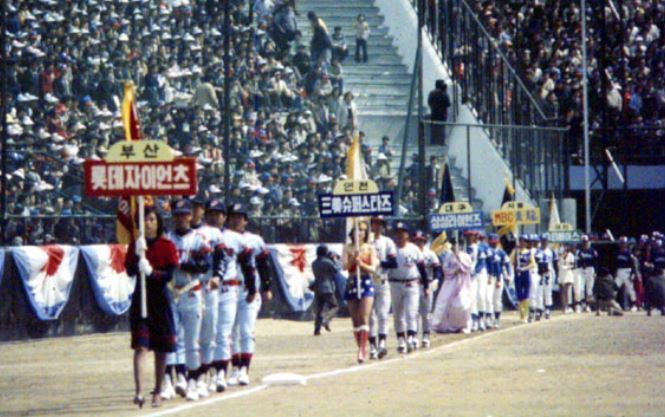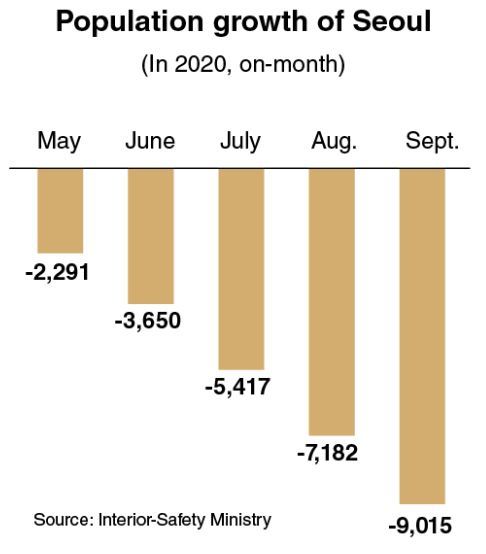[News Focus] Seoul population declines 1.27 million since 1992
This year, Korean capital loses 29,000 residents
By Kim Yon-sePublished : Oct. 8, 2020 - 15:05

SEJONG -- Seoul saw its population fall below 9.7 million for the first time in about 35 years in September.
According to the Ministry of Interior and Safety, the number of residents in Seoul stood at 9.699 million as of last month, down 9,015 (5,415 men and 3,600 women) from 9.708 million in August.
The capital’s population is estimated to have peaked at 10.969 million in 1992, which indicates that Seoul has lost 1.27 million residents (or 11.5 percent) in less than 30 years. The population fell below the 10 million mark in May 2016.
Among the first nine months in 2020, the figure for September marked the sharpest drop.
After posting positive growth in January and February, the tally for its registered residents slid by 3,307 in March, 6,868 in April, 2,291 in May, 3,650 in June, 5,417 in July and 7,182 in August on a month-on-month basis.
On a cumulative basis, the city‘s population declined by 29,875 for the first nine months of this year, which could suggest that the city is leading the era of population decline of South Korea in the coming years.

Over the past decade, a growing number of Seoul citizens have moved to Gyeonggi Province in the wake of spiraling apartment prices. Gyeonggi is still absorbing residents from the capital with its population reaching an all-time high of 13.38 million in September.
But the 2020 demographic data showed that the population decline is also seen in many of the nation’s 17 major cities and provinces, apart from Seoul. Among the eight major cities, seven posted negative growth last month.
Daegu followed Seoul with minus 1,379, followed by Busan with minus 1,323, Ulsan with minus 942, Incheon with minus 938, Daejeon with minus 332, Gwangju with minus 202. Only Sejong recorded positive growth by 782.
Of nine provinces, four -- South Gyeongsang, North Gyeongsang, South Jeolla and North Jeolla -- posted population drops.
Outside of Gyeonggi Province and Sejong, the other 15 cities and provinces saw the number of residents stall or continuously fall over the past few years.
The nation’s population decreased by 8,075 for the first nine months of the year, an unprecedented amount since the government started compiling the data.
After falling for the sixth consecutive month between January and June (minus 10,453 collectively), it inched up 2,378 between July and September.
“The coming figures for the remaining three months will draw wide attention, whether 2020 will mark the first year of negative demographic growth in the modern era,” said a government official.
Meanwhile, the number of births outstripped that of deaths -- 24,220 vs. 24,146 -- for the first time in 11 months in September, which led to an inching-up in population, alongside migrants acquiring Korean citizenship.
But deaths are estimated to outnumber the births again on a mid- and long-term basis amid little symptoms of an improvement in record-low fertility rates.
As for Seoul, one noteworthy point is that the city saw its portion of single-person households continue to grow, despite the population slide.
As of September, the number of single-person households came to 1.83 million in Seoul (41.7 percent of the total number of households). In September 2010, the figure was 1.44 million (35 percent of the total population, 4.11 million).
By Kim Yon-se (kys@heraldcorp.com)








![[Kim Seong-kon] Democracy and the future of South Korea](http://res.heraldm.com/phpwas/restmb_idxmake.php?idx=644&simg=/content/image/2024/04/16/20240416050802_0.jpg&u=)







![[KH Explains] Hyundai's full hybrid edge to pay off amid slow transition to pure EVs](http://res.heraldm.com/phpwas/restmb_idxmake.php?idx=652&simg=/content/image/2024/04/18/20240418050645_0.jpg&u=20240418181020)

![[Today’s K-pop] Zico drops snippet of collaboration with Jennie](http://res.heraldm.com/phpwas/restmb_idxmake.php?idx=642&simg=/content/image/2024/04/18/20240418050702_0.jpg&u=)